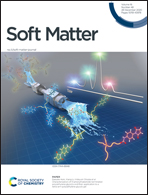Capillary interactions between soft capsules protruding through thin fluid films
Abstract
When a suspension dries, the suspending fluid evaporates, leaving behind a dry film composed of the suspended particles. During the final stages of drying, the height of the fluid film on the substrate drops below the particle size, inducing local interface deformations that lead to strong capillary interactions among the particles. Although capillary interactions between rigid particles are well studied, much is still to be understood about the behaviour of soft particles and the role of their softness during the final stages of film drying. Here, we use our recently-introduced numerical method that couples a fluid described using the lattice Boltzmann approach to a finite element description of deformable objects to investigate the drying process of a film with suspended soft particles. Our measured menisci deformations and lateral capillary forces, which agree well with previous theoretical and experimental works in case of rigid particles, show that the deformations become smaller with increasing particle softness, resulting in weaker lateral interaction forces. At large interparticle distances, the force approaches that of rigid particles. Finally, we investigate the time dependent formation of particle clusters at the late stages of the film drying.



 Please wait while we load your content...
Please wait while we load your content...